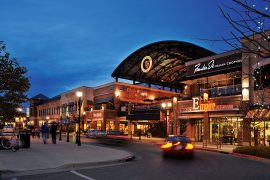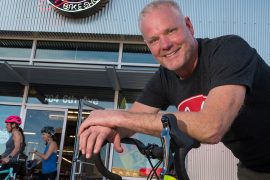After a quarter of a century the promise of Huntington’s SuperBlock will be realized with the 2002 opening of Pullman Square.
By Tamara Endicott
HQ 41 | WINTER/SPRING 2001
For the last 25 years, the idea of a SuperBlock project has reached legendary and mythical proportions. Huntington’s citizens and downtown business owners watched and waited for development and saw little more than tumbleweeds rolling through a large parking lot. Steiner & Associates, based in Columbus, Ohio, hopes to turn that skepticism into excitement with a project that will breathe economic life back into Huntington’s downtown area by the Fall of 2002. The name of the development is Pullman Square.
Nine years ago, Yaromir Steiner, president of the company, saw a need for a departure from the large enclosed malls, because he recognized that consumers were looking for a different experience. So he started a company with the idea of creating open-air developments that incorporate one-third retail, one-third dining and one-third entertainment. His concept has received nation-wide recognition in the trade industry. In an article by Shopping Center Business magazine, Steiner explains one of the reasons why consumers are choosing to spend their time at town centers instead of going to malls.
“Leisure time is the best way to describe what we do,” says Steiner. “It is really all about the customer. If the customer is coming for fun, then you are an urban entertainment center. If the customer is coming for shopping, then it is a shopping center. To have a leisure-time destination, it must be a place where people like to spend time. It must have an open-air component. If I ask you to name the great places that you like in the world, not one will be enclosed. People continually point out Union Square in San Francisco, ski resorts like Aspen, where the retail is open, and places like Larimer Square in Denver. The weather isn’t even a factor.”
The company recreates the kind of nostalgic experience people enjoyed when downtown areas were about walking the streets after dinner or a movie and peering into storefront windows. Steiner & Associates are instinctive in realizing that with today’s hectic schedules, Americans are looking for more. They want to return to a sense of community and a more leisurely pace during their down-time that enclosed malls can’t provide, says Tim Rollins, chief operating officer for Steiner & Associates.
“Creating this kind of environment and bringing the right kind of uses together is what we do,” says Rollins.

“We want to provide a place for people to come and park their car to spend an evening. They will be able to go to a movie, pop in some shops if they want to, grab a bite to eat or go to a comedy club. This open-air mix of uses that are put together in these projects doesn’t exist in most metropolitan areas outside of New York and Chicago. It’s not because people who live in New York are the only people who appreciate the urban experience, it’s because, in every city in America prior to World War II, those kind of rich experiences existed and Huntington is a perfect case in point.”
One of the reasons the SuperBlock project hasn’t been able to come to fruition before now is because the city wasn’t able to find the kind of developer willing to “marriage” the existing urban fabric with the SuperBlock area, says Jerry McDonald, president of the Huntington Area Development Council (HADCO). The relationship was founded between HADCO and Steiner & Associates two years ago when Bill Dargusch, of Continental Realty in Columbus, introduced the idea to Rollins. McDonald strongly agrees that Steiner & Associates have the right feel on the pulse of Huntington and what it needs to revitalize the downtown area.
“He’s the right developer with the right kind of project,” says McDonald. “I think the reason why many of those other projects failed over the last 25 years is because they were probably a little too grandiose. They were a little too outside what the market could bear. I think this is going to fit right into the market and right into downtown.”
With developments in metropolitan areas like Miami, Fla., Tampa, Fla., Columbus, Ohio, Newport, Ky. and Des Moines, Iowa, Steiner & Associates conducted market analysis surveys to find out if Huntington could support one of their centers. After determining that there is a large enough population base in the Tri-State area for a development, designs began and the project is now in the pre-conceptual stages with an opening date set for Fall 2002.
“In general, we found that people drive further for entertainment and shopping in Huntington than in a place like Columbus,” says Rollins. “We’ve done license plate surveys and customer intercept work, asking people, ‘How far do you come to find a custom trade area?’ We plotted all those points on the map and basically came up with a population base of 500 — 600,000 people that we think are the trade area for the project. And we’ve also found a real opportunity to interject a great project downtown with great restaurants and retail to create a very compelling environment.”
A frequent question Huntingtonians had for Steiner & Associates was whether or not the river-front area would be tied into the development. The desire to connect the project to the river was something they considered, but came to the conclusion that the need to connect to the downtown area was more vital, says Rollins.
They looked across the street to the vacant storefronts on Third Avenue and determined that it would more beneficial to rejuvenate those and focus the attention on downtown.
“In Huntington, because of the history of downtown and a lot of movement of retail out of the downtown core over a period of 30 years, it’s a fragile relationship that exists between new development and the existing area and we wanted this to be integrated into downtown,” says Rollins. “We opted to make a connection to the existing fabric, but having said that we are going to have a pedestrian bridge that goes over to the River Front Park. We would like very much to work on some joint marketing activity, because folks will spill onto the street after an event looking for something to do. The fact that we’ll have restaurants, shops and movie theaters, helps to get that area established as a gathering spot for the community and a hub for the Huntington marketplace.”

The economic death of downtown Huntington can’t be solely blamed on the incorporation of the Huntington Mall, says Rollins, although that was a major factor in the mass exodus of consumers out of downtown. The flow of traffic on Third Avenue is a major factor as well. The developers plan to pull the existing storefronts to the new project by shortening the width and turning the avenue back into a two-way street. The goal is to make the pedestrian feel comfortable moving from street to street.
“We’re students of cities,” says Rollins, “and we study what works and what doesn’t work both in terms of commercial space, but more importantly in terms of people space. When the building fabric is gone across the street, you’ve lost a big part of the charm of the street. When the traffic was modified in downtown Huntington, it was devastating. Third Avenue is essentially a throughway now, and that’s not a street. It’s sole purpose is to move people out of downtown as quickly as possible. When you start doing those kind of things to an existing urban core, it has devastating impact to the commercial spaces that are already there.”
Steiner & Associates’ designs are centered on the relaxation and pleasure of the consumer and take nothing for granted when it comes to the most minute detail. In the company’s Centro Ybor Center, in Tampa, Florida, they had to design the same feel and carryover the same atmosphere that the existing historical architecture and mood already provided. That same concept is what they are using to bring about a sense of unity between Third and Fourth Avenues. The company is excited about the opportunity to recreate the same “patina and feel” that makes Huntington’s downtown area unique, says Rollins.
“We set out to build great places where people want to be, where people want to spend time,” says Rollins.
“To do that you have to pay attention to all those detail designs, whether it’s the street width, where the trees are placed, where the park benches are and how the other buildings are oriented. All those things in a city with a rich history like Huntington are important because of the fabulous building stock that is already there.”
Other parallels between Centro Ybor and the Huntington project are the idea of working with local transportation to provide everyone the opportunity to enjoy the centers and offering a look into the history of the cities through museums located in the heart of the developments. In Centro Ybor, Steiner & Associates worked with the city’s trolley line to provide access for citizens, and in Huntington TTA will be offering the same benefit. The project’s museum will provide a look into Huntington’s history of river and railway transportation.

Steiner and Associates is still under negotiations at this time with possible lease contracts, and cannot divulge the identity of the future retail shops, restaurants and entertainment venues that will be offered to the Huntington community. Their ability to seduce interest from high-profile companies has not gone unnoticed. In the Easton Town Center, large metropolitan chains that had never considered opening in a smaller market like Columbus have experienced record-breaking numbers during their grand openings and have been encouraged by the consistent flow of consumers since Easton opened in June of 1999.
“A third of our tenant base is new to Columbus,” says Rollins. “There was no Cheesecake Factory in Ohio, no Virgin Records, no Planet Hollywood, no P. F. Chang’s in the state of Ohio and that stuff just doesn’t happen by accident. It’s not because P. F. Chang’s was dying to come to Columbus. It’s because we went out and knocked on the door and said, ‘There’s a compelling case here.’ “
Ken Busz, president of Huntington Regional Chamber of Commerce, says that he has heard nothing but excitement in the voices of the downtown business owners and Huntington’s citizenry who have been waiting a long time to see this happen.
Busz says, “It’s a fabulous idea that is going to benefit not only the city of Huntington, but the entire region. If we see them do half of what they did with the center in Columbus, the SuperBlock and Huntington will be very well off. I think the people are encouraged by the ideas of this particular developer, their plans and the scope of the project, so the feedback has been very positive. Steiner & Associates is a first rate company.”
Yaromir Steiner takes pride in being able to offer something more to consumers while restoring downtown areas that used to be the heart of the city and community activity.
“Development has been moving towards disintegration and specialization. Convenience without permanence,” says Steiner. “Urban scapes with no soul. We don’t believe in it. We believe that the beauty of urbanism is the planned integration of functions. It is the gathering of people in special places. We believe that this view of urbanism is seen in great cities or small villages that have developed through careful thought and planning unencumbered by euclidian zoning rules. We also believe it can be achieved through well-planned development. We believe people know the difference and will respond.”





